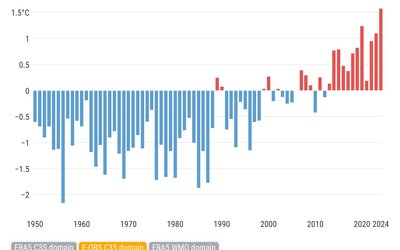Strong increase extreme heat events Portugal will have massive impacts
April 10, 2019

Photo: Wildfire in the north of Portugal, 2010 (source: Contando Estrelas, www.flickr.com)
The latest high-resolution climate models confirm earlier projections for mainland Portugal: hot days will get much hotter, and heat waves more frequent and extreme. These latest results are future projections for 2071 - 2100 (compared with 1971 - 2000, as a reference) based on a moderate and high-end scenario of climate change.
Maximum summer temperature may increase by up to 8°C
According to these projections, by the end of the century, the median values of maximum and minimum temperatures increase by 3.5 - 4°C and 3 - 3.5°C, respectively, under the high-end scenario of climate change. Maximum temperatures seem to increase more than minimum temperatures. Maximum temperature rise is largest in summer and autumn, with maximum increments of 8°C in some areas inland, whereas in winter and spring it is between 2 and 4°C.
Strongest changes near border with Spain
Future changes are not the same across Portugal. Projected rise in maximum temperature shows a large west-east gradient highlighting the lower warming in the coastal areas and the opposite near the border with Spain.
Up to mid-twenty-first century, the number of tropical nights is very similar across Portugal; from then onwards the differences between the coastal areas and inland become more substantial. Near the Spanish border, the number of tropical nights increases from an average of 7 now to possibly 60 tropical nights (under the high-end scenario) by the end of the century. Cold days almost disappear.
Heat waves more frequent and extreme
In this study heat waves are defined as periods of more than 5 consecutive days with maximum temperature higher than the 10% hottest days during the summer period (May – September) in the historical reference 1971 - 2000. The annual number of heat waves on average increases by seven to ninefold by 2100 near the Spanish border, under the high-end scenario of climate change. The general heat wave length increases from 5 days now to 22 days in 2100. 5% of the longest events will last for more than one month.
The future intensity (amplitude) of heat waves will be overwhelming larger, reaching values that have not been observed during 1971 - 2000. More than half of the heat waves will be stronger than the extreme heat wave of 2003 by the end of the century. The future heat waves will also enclose larger areas: on average more than 3 heat wave events will cover the whole country by the end of the century. For the moderate scenario the increase in the number of heat waves is milder, but even in this scenario, an average of 5 heat waves are projected for the end of this century.
Massive impacts
The authors of this study stress that future extreme heat events will have massive health, environmental and economic impacts. The 2003 heat wave was responsible for a 3.5% increase in mortality in Portugal and more than half of the heat waves by the end of this century may be stronger than this. Along with these heat extremes, an extension of the dry period and a significant reduction of precipitation are projected. This will strongly increase the hydro-meteorological hazards, like droughts, which will have severe impacts in river water quality, agriculture and forests. An amplified risk of increased aridity and large forest fires is thus foreseeable.
Source: Cardoso et al., 2019. Climate Dynamics 52: 129-157.








